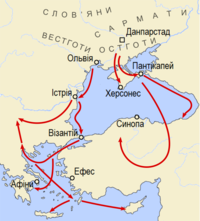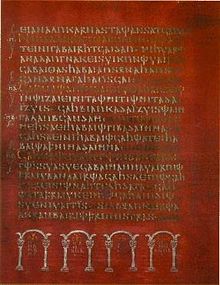Gothic Christianity
This articleneeds additional citations forverification.(July 2007) |
| Part ofa seriesof articles on |
| Arianism |
|---|
| History and theology |
| Arian leaders |
| Other Arians |
| Modern semi-Arians |
| Opponents |
|
|
Gothic Christianityrefers to theChristianreligion of theGothsand sometimes theGepids,Vandals,andBurgundians,who may have used the translation of theBibleinto theGothic languageand shared common doctrines and practices.
The Gothic tribes converted to Christianity sometime between 376 and 390 AD, around the time of thefall of the Western Roman Empire.Gothic Christianity is the earliest instance of theChristianization of a Germanic people,completed more than a century before the baptism of Frankish kingClovis I.
The Gothic Christians were followers ofArianism.[1]Many church members, from simple believers, priests, and monks to bishops, emperors, and members of Rome's imperial family followed this doctrine, as did two Roman emperors,Constantius IIandValens.
After their sack of Rome, the Visigoths moved on to occupySpainand southernFrance.Having been driven out of France, the Spanish Goths formally embracedNicene Christianityat theThird Council of Toledoin 589.
Origins
[edit]
During the3rd century,East Germanicpeople, moving in a southeasterly direction, migrated into theDacians' territories previously underSarmatianandRomancontrol, and the confluence of East Germanic, Sarmatian, Dacian and Roman cultures resulted in the emergence of a new Gothic identity. Part of this identity was adherence toGothic paganism,the exact nature of which, however, remains uncertain.Jordanes' 6th centuryGeticaclaims the chief god of the Goths wasMars.Gothic paganismis a form ofGermanic paganism.
Descriptions ofGothic and Vandal warfareappear in Roman records inLate Antiquity.At times these groups warred against or allied with theRoman Empire,theHuns,and variousGermanic tribes.In 251 AD, the Gothic army raided the Roman provinces ofMoesiaandThrace,defeated and killed the Roman emperorDecius,and took a number of predominantly female captives, many of which were Christian. This is assumed to represent the first lasting contact of the Goths with Christianity.[2]
Conversion
[edit]The conversion of the Goths to Christianity was a relatively swift process, facilitated on the one hand by the assimilation of Christian captives into Gothic society,[2]and on the other by a general equation of participation in Roman society with adherence to Christianity.[3]TheHomoiansin theDanubian provincesplayed a major role in the conversion of the Goths toArianism.[4]Within a few generations of their appearance on the borders of the Empire in 238 AD, the conversion of the Goths to Christianity was nearly all-inclusive.
The Christian cross appeared on coins in Gothic Crimea shortly after theEdict of Tolerancewas issued byGaleriusin 311 AD, and a bishop by the name ofTheophilas Gothiaewas present at theFirst Council of Nicaeain 325 AD.[2]However, fighting between Pagan and Christian Goths continued throughout this period, and religious persecutions – echoing theDiocletianic Persecution(302–11 AD) – occurred frequently. The Christian GothsWereka and Batwinand others were martyred by order ofWingurichca. 370 AD, andSabbas the Gothwasmartyredin c. 372 AD.
Even as late as 406, a Gothic king by the name ofRadagaisusled a Pagan invasion of Italy with fierce anti-Christian views.
Bishop Ulfilas
[edit]The initial success experienced by the Goths encouraged them to engage in a series of raiding campaigns at the close of the 3rd century, many of which resulted in having numerous captives sent back to Gothic settlements north of the Danube and theBlack Sea.Ulfilas,who became bishop of the Goths in 341 AD, was the grandson of one such female Christian captive from Sadagolthina inCappadocia.He served in this position for the next seven years. In 348, one of the remaining Pagan Gothic kings (reikos) began persecuting the Christian Goths, and he and many other Christian Goths fled toMoesia Secundain the Roman Empire.[5]He continued to serve as bishop to the Christian Goths in Moesia until his death in 383 AD, according toPhilostorgius.
Ulfilas was ordained byEusebius of Nicomedia,the bishop ofConstantinople,in 341 AD. Eusebius was a pupil ofLucian of Antiochand a leading figure of a faction ofChristologicalthought that became known asArianism,named after his friend and fellow student,Arius.

Between 348 and 383, Ulfilas likely presided over the translation of the Bible from Greek into the Gothic language, which was performed by a group of scholars.[5][6]Thus, some Arian Christians in the west used vernacular languages – in this case Gothic – for services, as did many Nicaean Christians in the east (theSyriacandCoptictranslations), while Nicaean Christians in the west only used Latin, even in areas whereVulgar Latinwas not the vernacular. Gothic probably persisted as a liturgical language of the Gothic-Arian church in some places even after its members had come to speak Vulgar Latin as their mother tongue.[7]
Ulfilas' adopted son wasAuxentius of Durostorum,and later ofMilan.
Later Gothic Christianity
[edit]The Gothic churches had close ties to other Arian churches in the Western Roman Empire.[7]
After 493, theOstrogothic Kingdomincluded two areas, Italy and much of the Balkans, which had large Arian churches.[7]Arianism had retained some presence among Romans in Italy during the time between its condemnation in the empire and the Ostrogothic conquest.[7]However, since Arianism in Italy was reinforced by the (mostly Arian) Goths coming from the Balkans, the Arian church in Italy had eventually come to call itself "Church of the Goths" by the year 500.
References
[edit]- ^Goff, Jacques Le (2000-01-01).Medieval Civilization 400–1500.New York: Barnes & Noble.ISBN9780760716526.
- ^abcSimek, Rudolf (2003).Religion und Mythologie der Germanen.Darmstadt: Wiss. Buchges.ISBN978-3534169108.
- ^Todd, Malcolm (2000).Die Germanen: von den frühen Stammesverbänden zu den Erben des Weströmischen Reiches(2. unveränd. Aufl. ed.). Stuttgart: Theiss. p. 114.ISBN978-3806213577.
- ^Szada, Marta (February 2021). "The Missing Link: The Homoian Church in the Danubian Provinces and Its Role in the Conversion of the Goths".Zeitschrift für Antikes Christentum / Journal of Ancient Christianity.24(3).BerlinandBoston:De Gruyter:549–584.doi:10.1515/zac-2020-0053.eISSN1612-961X.ISSN0949-9571.S2CID231966053.
- ^abHeather, Peter; Matthews, John (1991).The Goths in the fourth century(Repr. ed.). Liverpool: Liverpool Univ. Press. pp. 141–142.ISBN978-0853234265.
- ^Ratkus, Artūras (2018)."Greek ἀρχιερεύς in Gothic translation: Linguistics and theology at a crossroads".NOWELE.71(1): 3–34.doi:10.1075/nowele.00002.rat.
- ^abcdAmory, Patrick (2003).People and identity in Ostrogothic Italy, 489-554(1st pbk. ed.). Cambridge: Cambridge University Press. pp. 238, 489–554.ISBN978-0521526357.
